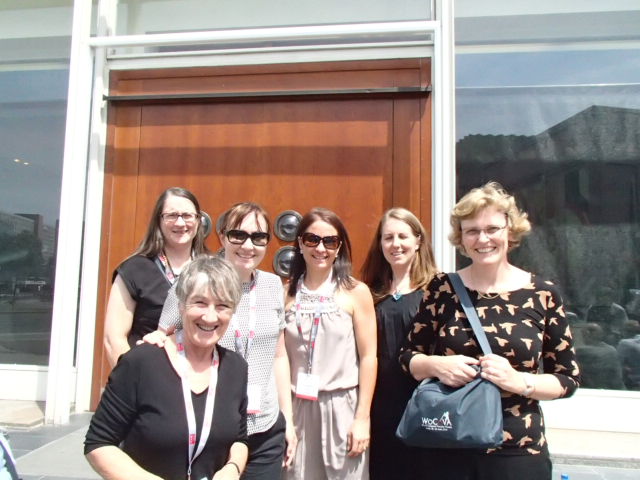|
AVATAR News
The Alliance for Vascular Access Teaching and Research (AVATAR) group continues to spread its wings.
What began in 2007 as a small group of intravascular researchers in Australia has morphed into a global
alliance with intravascular researchers, clinicians, educators and industry partners collaborating for
numerous research projects.
The AVATAR group researches and publishes extensively on all facets of
vascular access practice in hospitals and home care. Several large randomized controlled trials (RCTs)
are currently underway, examining diverse topics including device flushing, administration set replacement,
and dressing securement. In addition to clinical trials, the group has a strong microbiology arm, led
by Dr Li Zhang, PhD, investigating the role of biofilm in needleless connector and catheter complications,
and Dr David McMillan, PhD studying the infective potential associated with administration sets and dressings.
Vascular access education for clinicians is also a growing focus of the group, with a university accredited
course in IV insertion and management available.
WoCoVA, Berlin  The
AVATAR group wishes to thank the organisers of this year’s World Congress on Vascular Access (WoCoVA),
which was held in June in Berlin, Germany. The 3-day biannual congress was attended by over 1000 delegates
from many countries, with the AVATAR group delivering almost 20 presentations in addition to posters and
a pre-congress symposium to showcase the One Million Global Peripheral Intravascular Catheter (OMG PIVC)
study. Several members of the study team explained the study aims and methods, but the highlight of the
symposium was definitely Laura Alberto’s fabulous presentation describing how she has spread enthusiasm
for the OMG PIVC study throughout Argentina.
Other WoCoVA presentations from
AVATAR included:
Prof Claire Rickard (AU): “Securement of Peripheral IVs”
Dr Sam Keogh (AU): “Nursing and midwifery intravenous device flushing practice: A cross
sectional survey”
Dr Li Zhang (AU): “Bacterial Communities on Inner and Outer Surfaces
of Peripheral Venous Catheters”
Dr Niall Higgins (AU): “Translating vascular access
research for clinicians”
Peter Carr (AU) and Dr Jack LeDonne (USA): Inaugural WoCoVA Film
Festival
Peter Carr (AU): “The Emergency Department and peripheral cannulation”, “
Cochrane Protocol: Vascular access specialist teams for device insertion and prevention of failure”
Gillian Ray-Barruel (AU): “Inter-rater agreement of phlebitis assessment symptoms and scales”
Nicole Marsh (AU): “Securing peripheral venous catheters in hospitals: can we do better
at preventing catheter failure?”
Heather Reynolds (AU): “Securing arterial lines effectively
in the operating theatre and the ICU: A pilot trial”
Nicole Gavin (AU): “Does parenteral
nutrition promote microbial growth? A review of clinical and laboratory findings”
Julie Flynn
(AU): “Sterile versus aseptic non-touch technique when changing the bung on a central venous access
device: A retrospective cohort study”
Rand Butcher (AU): “The quality of published central
venous catheter clinical practice guidelines: a systematic appraisal using the AGREE II instrument”
Azlina Daud (Malaysia): “Replacement after standard versus prolonged use of administration
set for arterial catheter in an Australian intensive care unit: a feasibility RCT”
Tim Spencer
(AU): “Expanding field of competence for clinicians - from PIVs to CICCs”, “Malpositioned
PICC tip repositioning using a high-flow flushing technique - a review of clinical practice, procedural
outcomes and cost implications for clinicians”
Sheila Inwood (UK), “How does a clinician
choose needle free connectors: are there evidence based recommendations?”
Poster presentations:
Tricia Kleidon: Taurolidine-Citrate line locks prevent recurrent catheter related bacteraemia - Evaluation
of this novel therapy in a paediatric population
Tricia Kleidon: An intervention to reduce catheter
related blood stream infections in paediatric patients - a bundle of care
Samantha Keogh: A time
and motion study of peripheral venous catheter flushing practice using manually prepared and pre-filled
syringes
Amanda Ullman: Dressings and securement devices for central venous catheters (CVC): a systematic
review
The team looks forward to showcasing more research and building further networking alliances
with our international colleagues at the upcoming AVA conference in National Harbour, Maryland, in September.
If you’ll be there, come and say G’day! OMG Study Update
With a focus on exploring clinical practices in PIVC insertion and management,
the OMG PIVC study continues to expand recruitment. The one-day prevalence study will provide previously
unavailable data for benchmarking PIVC clinical practice across the globe. More than 430 hospitals in
40 countries (including 10 languages) have decided to participate. Most are in the stage of achieving
local approvals (management and ethics, as needed), and a handful of hospitals have already completed
their data collection. The study will continue to recruit hospitals until December 31, 2014. If you would
like to learn more or register your interest in the study, please go to www.omgpivc.org. |